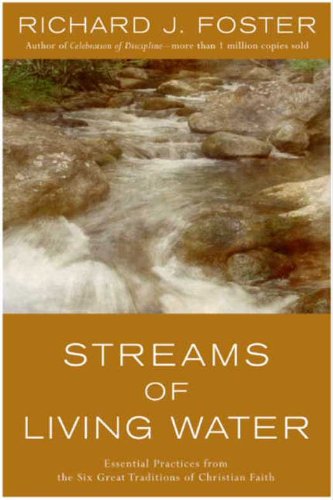Streams of Living Water
Historically, there have been six dimensions of the spiritual life that have been emphasized or de-emphasized in the church based on geography, time-period, leadership, culture, and theology.
Here are the six traditions:
- The Contemplative Tradition
- The Holiness Tradition
- The Charismatic Tradition
- The Social Justice Tradition
- The Evangelical Tradition
- The Incarnational Tradition
In this blog, I want to highlight each tradition so you can see what they are, how they’ve influenced the church over the years, what opportunties each one brings to our spiritual growth, and what possible threats to growth that may arise if not properly understood.

The Contemplative Tradition
Discovering the Prayer-Filled Life
What is it?
Why should we explore it?
Character Studies:
-
it constantly fans the flames of our “first love”
-
it forces us beyond merely a cerebral religion
-
it stresses upon the centrality of prayer
-
it emphasizes the solitariness of our life with God
-
the tendency to separate it from ordinary life
-
the tendency to consume asceticism
-
the tendency to devalue intellectual efforts to articulate our faith
-
the tendency to neglect the importance of the community of faith
The Holiness Tradition
Discovering the Virtuous Life
What is it?
Why should we explore it?
Character Studies:
-
a focus on the ultimate goal – transformation
-
a focus upon the heart, the wellspring of action
-
a hope for genuine progress in character formation
-
an understanding of how to “grow in the grace and knowledge of our Lord and Savior Jesus Christ.” (2 Peter 3:18)
-
legalism
-
Pelagianism
-
perfectionism
The Charismatic Tradition
Discovering the Spirit-Filled Life
What is it?
Why should we explore it?
Character Studies:
-
it offers an ongoing correction to our impulse to domesticate God
-
it offers a constant rebuke to our anemic practice
-
it offers a continuing challenge toward spiritual growth and development
-
it offers a life of gifting and empowering for witness and service
-
the danger of trivialization
-
the danger of rejecting the rational and the intellectual
-
the danger of divorcing the gifts of the Spirit from the fruit of the Spirit
-
the danger of linking our walk in the Spirit to highly speculative end-time scenarios that lack theological foundation
The Social Justice Tradition
Discovering the Compassionate Life
What is it?
Why should we explore it?
Character Studies:
-
mishpat = justice
-
hesed = loyal love
-
shalom = peace
-
personal
-
social
-
institutional structures
- Calls us to a right ordering of society (right relationships + right living).
- Enhances our ecclesiology, our doctrine of the Church.
- Promotes harmony in relationships between peoples so that we can learn to live together not just with civility but with genuine appreciation.
- Provides a bridge between personal ethics and social ethics.
- Gives relevances and bite to the language of Christian love.
- Gives us a foundation for ecological concerns.
- Holds before us the relevance of the impossible ideal.
- The tendency to become an end in itself.
- The tendency of strident legalism.
- The tendency to hold a political agenda.
The Evangelical Tradition
Discovering the Word-Centered Life
What is it?
Why should we explore it?
Character Studies:
-
the evangelical call to conversion.
-
the evangelical stress upon Christ’s missionary mandate to disciple the nations.
-
the evangelical commitment to biblical fidelity.
-
the evangelical witness to sound doctrine.
-
the tendency to fixate upon peripheral and nonessential matters.
-
the tendency toward a sectarian mentality.
-
the tendency to present too limited a view of the salvation that is found in Jesus Christ.
-
the tendency toward bibliolatry.
The Incarnational Tradition
Discovering the Sacramental Life
What is it?
Why should we explore it?
Character Studies:
-
it underscores the fact that God is truly among us
-
it roots us in everyday life
-
it gives meaning to our work
-
it is a valuable corrective to Gnosticism
-
it constantly beckons us Godward
-
it makes of our body a portable sanctuary
-
it deepens our ecological sensitivities
-
idolatry
- managing God through externals (“come to this church and follow this ritual system to find God”)
Application
Reflection Questions
- Which stream are you most comfortable with or identify with the most?
- Which stream are you least comfortable with or identify with the least?
- How can you grow more in this stream?
- Why do you think it’s important to understand each traditions opportunities and threats?
- Why do you think it’s important that learn about Christians from history and their apprenticeship to Jesus?
Matt Garcia
Matt is the creator of this website and curates resources on spiritual formation. He is a husband of Jesika and a father of 4 children. He also helps lead a house church. Follow him on Instagram to see what he's up to.

